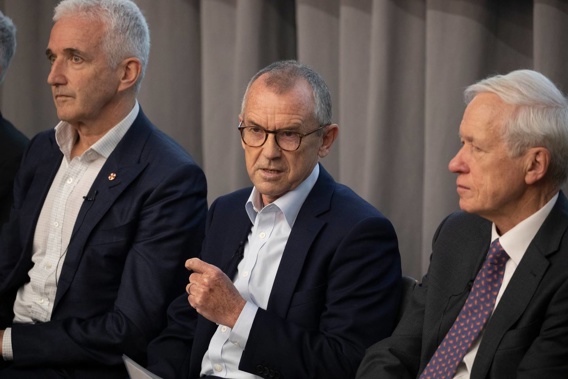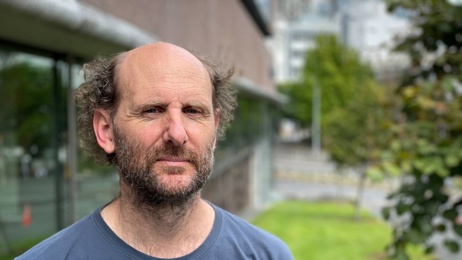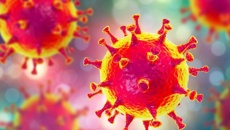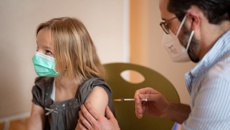
Covid-19 Independent Continuous Review, Improvement and Advice Group chair Sir Brian Roche says between now and Christmas "there is going to be a lot going on" with the country's Covid protection framework.
"Certainty is something that society and community need," he told Newstalk ZB host Heather du Plessis Allan this afternoon.
"We believe there was scope to be better prepared," Roche told du Plessis Allan of New Zealand's response to Covid-19.
Earlier today it was reported Auckland could have exited level 4 lockdown five days earlier, based on advice provided to Cabinet ministers from director general of health Dr Ashley Bloomfield.
The advice revealed a level of optimism at the time around the outbreak, with a belief case numbers had peaked on August 28, and that it was still possible to eliminate the virus.
The briefing, produced on September 12 the day before an alert level review, also advised there was potential for the rest of the country to move to alert level 1 at a later date.
The briefing is one of many pieces of information revealed in a tranche of official documents the Government has dumped today.
Bloomfield advised the Government Auckland could move to alert level 3 from 11.59pm on Thursday, September 16, with a review in just under two weeks on Sunday, September 26.
He said the outbreak was becoming "contained to clearly identifiable communities within South Auckland", and appeared to have peaked on August 28.
However, the daily numbers had plateaued at around "10 to 20 cases since September 4".
"We may see a long tail of a few cases, which it will be important to track to minimise the chances of further outbreaks.
"While a move to alert level 3 will increase movement, cases are currently linked, or are being linked to known clusters.
"Two weeks at alert level 3 will provide the necessary surveillance and ability to rapidly respond if there was further transmission outside of clusters or communities of concern in Auckland."
Bloomfield also recommended ongoing community engagement to build trust and maintain high rates of vaccination in Auckland, particularly in Māori and Pacific communities in South Auckland.
Bloomfield said Auckland could have even moved down on September 14, but the two extra days were needed due to new cases emerging in unknown clusters, reports of bubble breaches and the "long tail of cases".
A Cabinet paper produced the following day by the Covid-19 Response Minister's office added the option of lowering alert levels on September 21, citing further increase in case numbers. It stated however the outbreak was increasingly under control and on track for an "eventual" return to elimination under level 4 settings.
Subsequently Prime Minister Jacinda Ardern announced an in-principle decision to move Auckland to level 3 five days later than Bloomfield's initial advice, on September 21.
Bloomfield further advised Cabinet could decide to move the rest of the country to alert level 1, pending no escalation in Auckland's Covid-19 risk, when it met on September 20.
The Government document dump on alert level restrictions shows ministers were told the restrictions had Bill of Rights considerations.
Exactly what those were was not released - while most of the information was disclosed, the Government redacted what it was told from the documents on the basis it was legal advice.
Independent expert's scathing report
An independent expert group told the Government in September that the borders cannot start to reopen until vaccination coverage was "well over" 90 per cent and the shortfall for Māori was addressed.
A September 23 letter from Sir Brian Roche, head of the Government's independent continuous improvement group, also said bolstering testing and contact tracing was an urgent priority, and the Delta outbreak had shown a "very poor level of preparedness of hospitals".
The letter and accompanying report is revealed in a tranche of official documents that the Government has dumped today.
"Timing is critical. We need to move with urgency to ensure we do not expose the country and New Zealanders to unnecessary risk and harm," the report said.
"We are mindful that even the most conservative scenario post-reopening will inevitably involve the virus, in one form or another, making its way into the community for periods of time, or even permanently.
"Such a scenario may have previously been seen as alarmist, but is inevitable, in our view, based on what we observe from the most recent outbreak together with international experience."
The report also noted how the vulnerable in Auckland were not adequately protected in the current outbreak.
"Assurance is also needed that a phased reopening identifies, supports and protects the vulnerable.
"There have been examples of that not being the case for some sections of the community during the current outbreak. Addressing this will be critical to minimise issues of inequity within the community."
Roche's letter, addressed to Covid-19 Response Minister Chris Hipkins, said that the outbreak had "exposed urgent issues with respect to New Zealand's preparedness for reconnecting".
"Delta has fundamentally changed the model of preparedness and response and we must adapt accordingly. We do not have a do nothing option."
Roche said reopening the borders were a four-pronged approach: Vaccination, border processes, public health measures, and the health system safety net.
"Vaccination coverage will need to be well over 90 per cent and it is clear that our New Zealand vaccination programme is failing certain populations, most notably Māori, who are at higher risk of serious disease and death than non-Māori. Addressing such disparities is an urgent priority."
He called for all efforts to take the vaccine to communities, and for more funding. A month later, the Government announced $120 million to boost Māori vaccination rates.
Roche said more movement across the border was "essential … to address escalating economic and social harms", including alternatives to MIQ and more saliva testing and rapid antigen testing.
Roche has previously implored the Government for more widespread use of different testing methods, including in a report from September 2020.
He has also previously told the Health Ministry to bolster contact tracing capacity, and did so again in his September letter.
"This has been the subject of recurring recommendations from our reports and needs to be addressed as a priority.
"In addition, ongoing issues with innovation around testing and electronic contact tracing enhancement need to be resolved. Rapid antigen testing is a critical prerequisite – we cannot afford the delays in its introduction that have been experienced with saliva testing."
The report added that the backlog and testing delays at the start of the outbreak – when people waited up to 12 hours in line – ended up "compromising early outbreak containment".
"A lack of prioritisation meant that priority workers and key locations of concern were not processed with urgency.
"The ability to detect and respond immediately will be a key element of success. It is our view that rapid antigen testing is introduced for areas that have vulnerable groups, before entry into hospitals, aged residential care facilities, prisons, forensic facilities, and so forth."
Only yesterday did the Government reveal that rapid antigen testing would soon be available in pharmacies and to more businesses.
Finally, he said the outbreak had exposed how poorly hospitals were prepared for Delta.
"The system's ability to deal with Delta and other business as usual functions of the health system has been found wanting.
The report added: "DHB Chief Executives and Chairs have recently written to the Minister of Health that they are not confident in the level of preparedness planning.
"The current outbreak has revealed the very poor level of preparedness of hospitals for Delta. Auckland, which has a large and Covid-19 prepared health system relative to the rest of New Zealand, has essentially been stretched to capacity.
"Significant amounts of planned care have been placed on hold. This is unsustainable as the health system must be able to do 'business-as-usual activity' as well as be equipped to deal with Covid-19.
"We are seeing from overseas evidence that even at 80 per cent vaccination rates hospitals and health systems are under significant pressure. There is also a lot of evidence that the 'missing 20 per cent' are likely to be at high risk of poor outcomes. Current Ministry of Health vaccination data by ethnicity shows this trend extends to New Zealand."
Roche said the outbreak had also "exposed the shortfall in proper engagement of Māori and Pacific providers in the outbreak and overall response".
Māori and Pacific providers have consistently been arguing to be a central part of leading the community response, rather than through DHBs, which the Government has conceded has led to poor outcomes in some regions such as Taranaki.
Roche repeated his concern about the response being reactive rather than prepared in anticipation of the worst.
"The current operating model is failing, and will fail in the even more complex operating environment after re-opening."
A fully integrated pandemic preparedness and response unit – which he has previously called for - was needed, he said.
"We recommend that this unit is put in place before the end of the vaccination rollout as the current arrangements put the country at unnecessary risk."
Hipkins welcomed Roche's report, saying it had helped inform the Government's improvements to the response since September.
"Progress has also been achieved in key areas highlighted by the group, with more testing and surveillance testing options, including saliva testing and rapid antigen tests for business, and mandatory vaccine requirements for the border, education and health sectors, Corrections, the Police and Defence – providing more protection and certainty."
Auckland outbreak 'now at risk of becoming uncontrolled'
An October 18 review of alert level settings - the most recent such report released today in a cache of Covid-19 documents - warned that Auckland's outbreak was "now at risk of becoming uncontrolled". The report, at the same time, pointed to cracks starting to show in the MIQ system.
"There has been a significant increase in the number of unlinked cases in Auckland" and that is due in part to "there being less investigation of the source of infection as the Auckland Regional Public Health Service moves to a more sustainable case investigation model as case numbers increase", the report stated.
The report also warned that case and contacts management has "become more complex due to the communities that have been affected".
"Public health units advise that each of these cases is taking up the time of two less complex cases, placing strain on the workforce. Additional support is being provided by public health units outside of Auckland and National Investigation and Tracing Centre surge capacity has been activated."
The health workforce at Auckland MIQ facilities "is reaching its limits and work is underway to redeploy staff from across the motu".
"The number of cases from the community being managed within the MIQ systems is presenting additional stress on the system...Officials are considering options to free up capacity in MIQ facilities. These include options of self-isolation, reduced quarantine period and short stay options."
A public health assessment from a few days earlier - October 14 - revealed that the level of risk in Auckland had moved from medium to high. "There is ongoing and accelerating transmission in Auckland," a public health advice memo to Ashley Bloomfield said, noting that the outbreak - previously centred on South Auckland, was now more widespread.
"It is affecting more ethnic groups with more exposure events per day and more exposures occurring outside of home and essential workplaces."
"There continues to be a shift from complex households being the focus of concern to an increase in cases amongst various forms of residential housing and healthcare facilities across Auckland. There has also been a significant increase in the number of unlinked cases."
"There is a likelihood of undetected community transmission across Auckland."
The memo noted that a return to level 4 may not have the desired effect because of the effect it would have on Aucklanders' well-being, and no guarantee it would work because it relied on social compliance.
It also recommended mandatory vaccinations for essential workers crossing the Auckland boundary, which the Government rejected as impractical.
Optimism a month into level 4 came with caveat - memo reveals
Less than a month after the first Delta case, Cabinet was told the level 4 restrictions were working.
"There are several reasons to be increasingly confident that the outbreak in the Auckland region is contained," Hipkins told colleagues.
He said the case numbers appeared to have peaked on August 28 and the number of cases in the community was declining even as those the percentage of cases linked was increasing.
The optimism came with a caveat about unlinked cases and a concerning subcluster in Mangere. There was also concern over a decline in testing numbers.
That optimism was endorsed by Bloomfield on September 19, who Hipkins said was "confident that the outbreak in the Auckland region is contained".
It prefaced the decision to move Auckland out of level 4 on September 21, which the Cabinet papers showed also took into account the wearing effect of the lockdown.
"Public attitudes of general fatigue are intensifying and willingness to comply with some public health measures is reportedly reducing," Cabinet was told.
It was a Cabinet paper that came with modelling warning of a "long tail" in the Delta outbreak and a "greater risk that cases may begin to rise again".
A month later, on October 4, that predicted "long tail" was proving troublesome, as was waning public support.
Hipkins told Cabinet that further loosening of lockdown restrictions were a balance of the "public health risk presented by the continuing spread of the virus" and "evidence of eroding social license".
It was at this Cabinet meeting the growing numbers of those vaccinated was offered as a positive balance to persistent emerging cases.
It was also at this meeting Hipkins talked of modelling around a shift to level 2 for Auckland, saying: "This poses the question whether we should set a vaccination target for Auckland – something we could give further thought to."
Hipkins also raised the pressure managing the outbreak had placed on the country: "If there were another significant incursion-outbreak in the next two months New Zealand would struggle to respond like it has in this August outbreak."
The beginning
Six days after the first known case of Delta in New Zealand, a Cabinet paper from Covid-19 Response minister Chris Hipkins shows how much uncertainty existed in the Beehive.
It showed health authorities knew of 13,000 contacts and more than 300 locations of interest - a fraction of the number they are currently dealing with. Among those were high-risk settings including churches, health facilities and a University of Auckland ball attended by 500 people.
Hipkins told Cabinet cases had been found in Wellington and known close contacts had travelled elsewhere in the country. About 6500 contacts' locations had been confirmed, of which 100 had South Island addresses.
Accentuating the risk was the dispersal of people across the country ahead of the level 4 restrictions coming in, Cabinet was told.
Hipkins' briefings to Parliament underscored the importance of "social licence" - the term denoting public approval for government measures.
With lockdown just six days old, "most people are happy or okay" about level 4 but there had been a "significant shift from neutrality and joy in July to negative emotions in August".
"South Islanders are significantly more likely to feel disgust (23 per cent) than the total sample (7 per cent)."
There was also concern over reports from police of non-compliance with Hipkins noting protests and "parties are an ongoing issue".
'Uncontactable' cases presented health system headaches, memo shows
Uncontactable cases presented headaches for the health system when the Delta outbreak intensified in some residential complexes, healthcare facilities and educational centres.
An October 28 memo to Dr Ashley Bloomfield showed private gatherings, even those of the type allowed under level 3, were major drivers of transmission.
"Several cases have been identified in high-risk settings including residential housing and health care settings," the memo added.
"It has been noted that there are ongoing issues of cases being uncontactable, which are being rectified with the use of finders services."
The memo from health officials indicated contact tracing was functioning well, even though by this point 2036 open contacts and 36,352 contacts with an Auckland quarantine address had been recorded.
Hospitals and the health system were coping - but officials warned that hospitalisations might not peak until late November.
It was especially encouraging to see a relatively small number of people needing intensive care, the memo added.
This low rate was probably because the average age of all Covid cases and hospitalisations was only 30, officials said.
What pre-Delta outbreak survey revealed
A study of 976 Aucklanders aged 15 years and over was conducted between March 7-17 after Auckland moved from Alert Level 3 to Alert Level 2.
The majority (75 per cent) of people surveyed by the Government said New Zealand was going in the right direction with the Covid-19 response.
The 12 per cent of people who said we were going in the wrong direction were most likely to be self-employed or thought they were not being told all they needed to know.
They were concerned about the vaccine and about borders opening, 12 per cent were not sure.
Most people surveyed were positive about the future but there was a group who felt their life was worse than before Covid.
These people are most likely to be 55 years+ and self-employed or seeking work.
Only 9 per cent of New Zealanders believe that getting the country vaccinated will return life to how it was pre-Covid-19.
36 per cent expected to continue to undertake health behaviours.
47 per cent expected there to be some differences in day to day life compared to pre-Covid-19.
Take your Radio, Podcasts and Music with you









